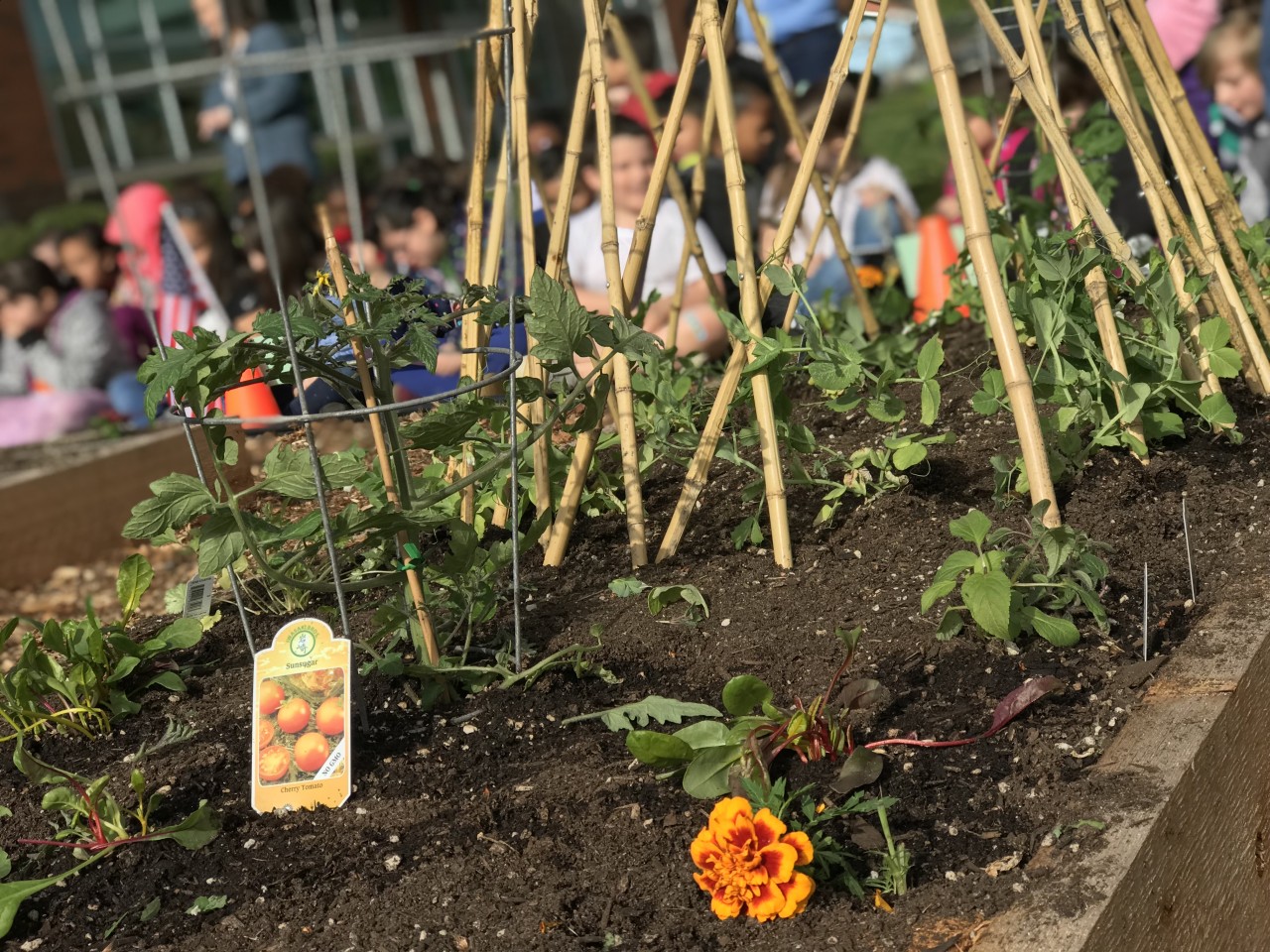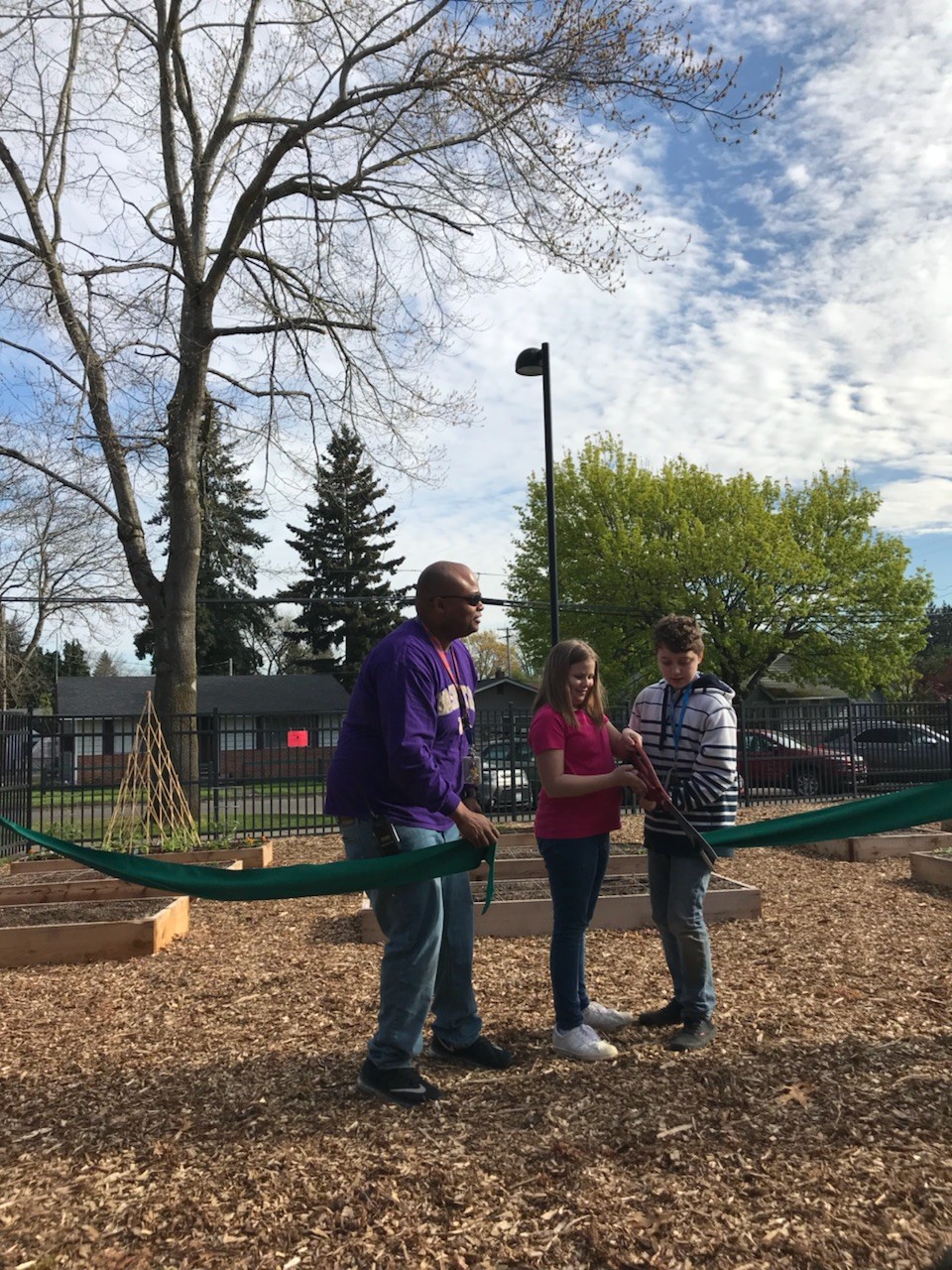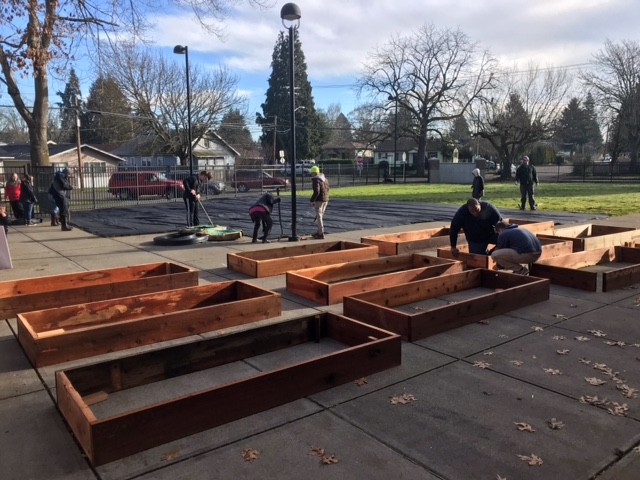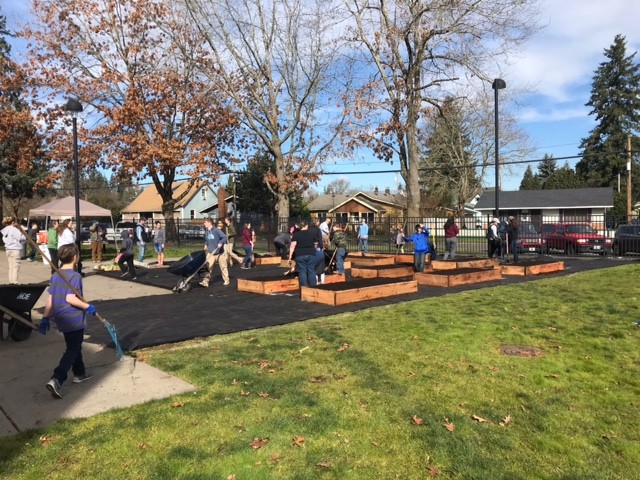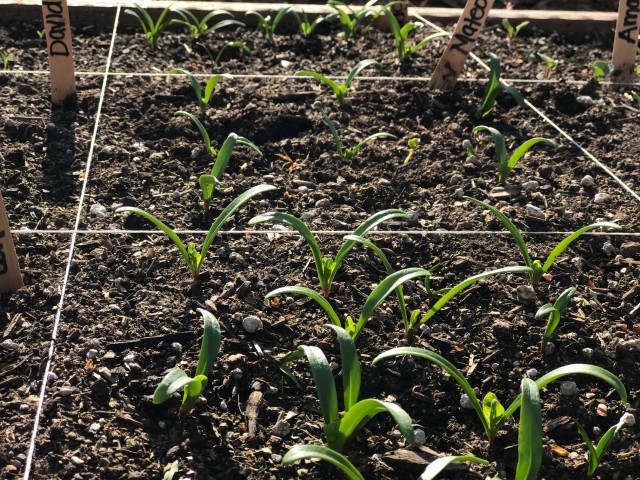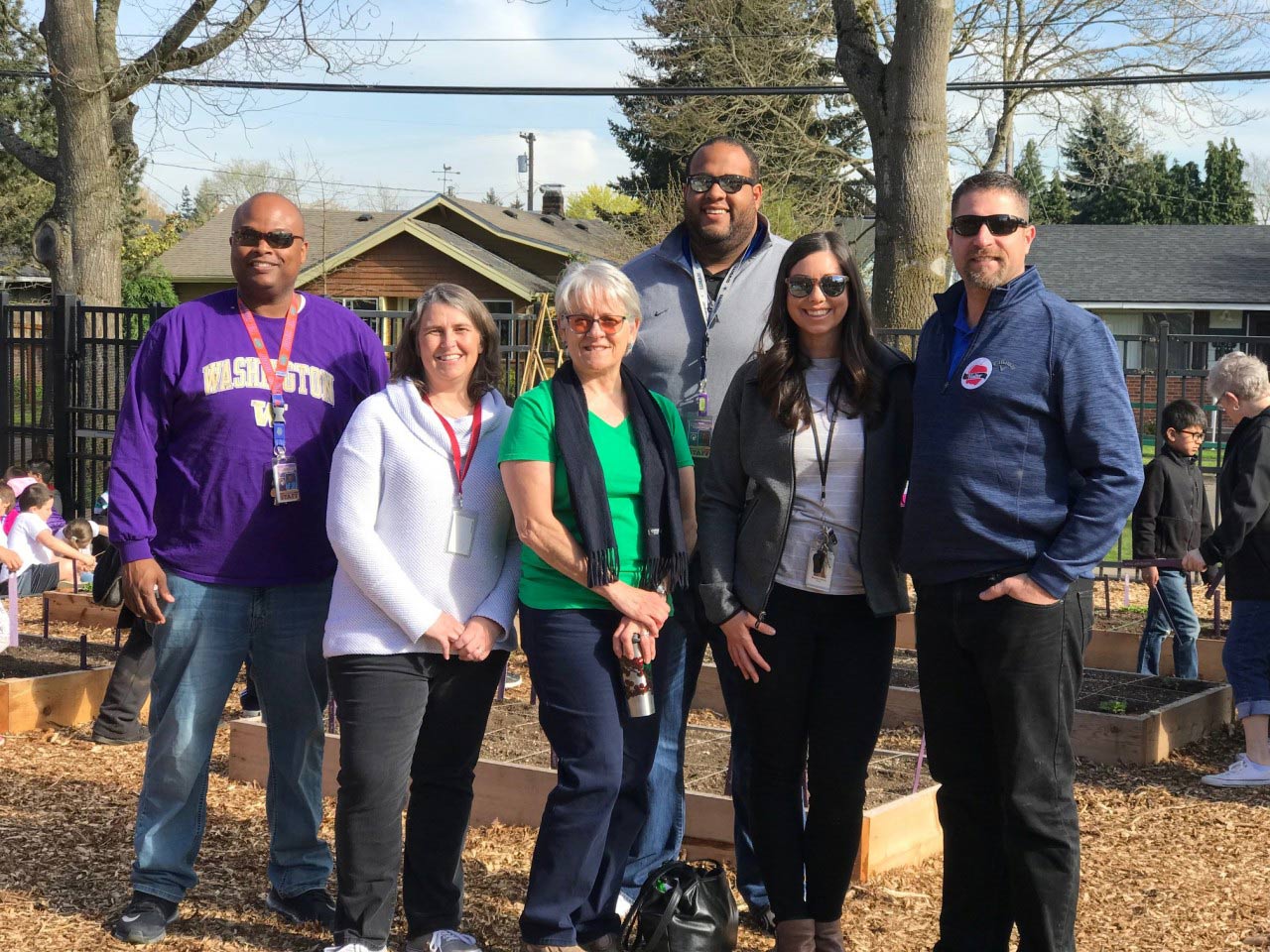Clark County Green News
Washington Elementary starts a school garden and brings a community together
Vancouver Public School's Washington Elementary held a "green ribbon cutting" for their garden opening last Friday. They enjoyed sunny skies for their community celebration where they unveiled 13 new raised garden beds, heard from principal Kirsten Copeland and several students who helped get this project off the ground.
Melissa Hendy, 4th grade teacher and garden coordinator, answered a few questions for Clark County Green Schools. We wanted to hear how this all got started, what obstacles they faced, how they are incorporating it into the school culture and what their plans are moving forward.The excitement of the students is palpable and I have already seen the tremendous effects it has had on bringing our school and community together.
Melissa Hendy
4th grade teacher and garden coordinator
Washington Elementary
CCGS: How did this garden idea get started?
Hendy: The 5th graders were given an assignment to write a persuasive paper to the principal about how to improve the school. As they toured the school looking for ideas, they noticed all of the grass in the back of the school that is hardly used. That sparked an idea for them to persuade Mr. Copeland to let them build a garden as their legacy project.CCGS: How will you integrate it in to class time and curriculum?
Hendy: The garden has already seamlessly made it into our classrooms in a variety of math, science, reading and writing lessons. Students calculated the area of the raised beds, measured the square foot grids, used math arrays to make seed papers for planting, learned about the plant life cycle, observed the parts of a seed, parts of a plant, read about vegetables, researched what plants would grow best, wrote about their favorite aspects of the garden, problem solved as issues arose in the garden and many more opportunities will continue to present themselves as the garden grows. It is hands on learning with high engagement and I know that the lessons learned in our garden will be some of the most memorable for our students.
CCGS: Who will maintain the garden going forward?
Hendy: During the school year, classroom teachers will each be responsible for their raised beds. As acting garden coordinator (self-appointed) I will continue to monitor the garden and be the point person for teachers to contact for problems or questions.
In the summer, we are working on a program for community members to come in and lead lessons on garden maintenance as well as harvesting. The Boys and Girls Club are stationed here in the summer, so we already have kids and volunteers at the school. We just need to provide garden experts to continue to teach the lessons in the summer.
CCGS: Tell me about the sticks with the students' names on them? I saw the students putting them in the garden at the ribbon cutting.
Hendy: The plant sticks will be a visual indicator of when each square foot will be planted. Each bed has a dimension of 8 x 3 which provides 24 squares which translates to at least one square for each student in a class. I used the website Gardeners Supply Company: Kitchen Garden Planner to design our garden site plan and then provided each class with a map of their garden crops. Teachers then assigned each student a square or two to plant.
The process of planting needs to be done in small groups of 4-5 students which means they all aren't planted at once. So having a garden marker (plant stick) to represent when the square has been planted is a great way for us to keep track of what squares still needs to be planted. The students can write their name on one side which gives them ownership of their square and the other side will have the name of their crop.
Some of the beds were planted before spring break and didn't have markers indicating they were planted. When we came back after break, we found evidence that dogs were running through the beds, destroying some of the square foot grids. I didn't want that to happen once the little seeds sprouted.
I thought the paint sticks would be useful to give the kids ownership, provide a powerful visual of student ownership during the opening ceremony, utilize a signal when the squares have been planted, and to indicate the crop that is in each square. I am hopeful that it may have also started a tradition for our school to kick off the garden each spring with a small celebration where we can come together to place our plant sticks.
At the end of the day on Friday, I witnessed several students walking their parents to proudly show off their plant stick with a big smile on their face.
Below you'll find the site plan I made as well as an example of one garden bed for reference. The teachers have the freedom to modify, but I provided the map and seeds to each teacher in order to ensure the beds would be planted, regardless of garden experience and/or knowledge.
CCGS: Who is to thank for helping contribute?
Hendy:
- The 5th grade students and teachers for giving them an opportunity to share their opinion and to make a difference.
- Mr. Copeland for honoring the idea, speaking to donors to gather the funds and for bringing the community together to get the project started. He also was there for the day of the garden build and has encouraged teachers to use this project based learning to increase student engagement and STEM learning.
- Mrs. Owen for planning the initial garden meetings, gathering the materials and supplies, keeping the donors notified of the progress, writing requests for donations, and many other tasks that she took on in order to keep the project on schedule.
- Otak and Allen Hendy for donating their time to design the garden. There were many preliminary designs that were modified at the meetings based on the ideas shared by students. They also changed the location of the garden based on feedback from staff and to improve practicality for irrigation and student access. Allen is an engineer who utilized his project management skills to help ensure that on the day of the garden build, it was a success. He truly helped keep the momentum going with the garden project, when it felt like an overwhelming task for us.
- Americans Building Community non-profit that is run by Mark and Patti Maggiora. They contributed useful ideas for the garden based on their previous experience of building community gardens. They attended meetings, gave us contacts to help the process and were there for the building of the garden. Patti also has donated her time to coming in to classrooms to lead lessons in planting the garden.
- Kris Potter is a Master Composter/Recycler and garden educator is the founder of Family Gardening and works at River HomeLink. She has attended nearly all the meetings and connected us to the local gardening community. She donated the seeds for the garden and provided an invaluable amount of information about getting this project off the ground.
- Heather Todd, a paraeducator at Washington has also attended the meetings, helped to build the garden and continues to support this project in any way she can.
- Shurway gave us a discount on the wood for the raised beds, Shorty's gave us a significant discount on the soil, Arborscape donated the bark chips, and Lowe's donated the paint sticks for the grand opening of our outdoor classroom.
- Everyone who participated in the garden build. We ended up with over 40 volunteers consisting of staff, students, parents and community members. We were able to make the garden come to life in 4 hours. Constructing and placing 13 raised beds, laying down weed mat, adding soil, bark chips and edging was no easy task. It was incredible to witness such an accomplishment.
- There were many other community members and businesses that have supported this work and we are so grateful for everyone who has made this dream a reality.
This has been one of my greatest dreams and to see it come to fruition truly makes my heart soar. The excitement of the students is palpable and I have already seen the tremendous effects it has had on bringing our school and community together.
Congratulations to Washington Elementary for creating a beautiful garden space for the school community to learn from and enjoy! Thanks for sharing so much of your journey with us so others can benefit!
When you subscribe to the blog, we will send you an e-mail when there are new updates on the site so you wouldn't miss them.

